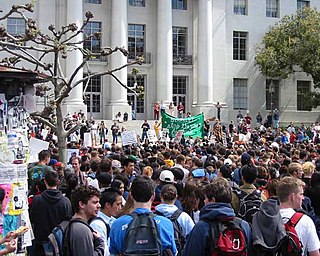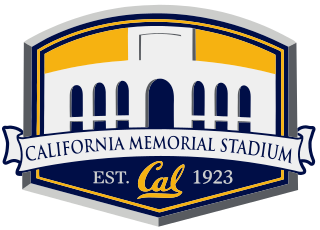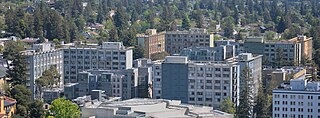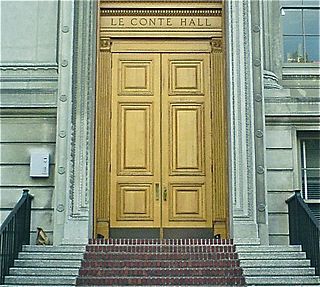
The University of California, Berkeley is a public land-grant research university in Berkeley, California. Founded in 1868 and named after the Anglo-Irish philosopher George Berkeley, it is the state's first land-grant university and is the founding campus of the University of California system.

The University of California, Davis is a public land-grant research university in Davis, California, United States. It is the northernmost of the ten campuses of the University of California system. The institution was first founded as an agricultural branch of the system in 1905, known as University Farm, and became the seventh campus of the University of California in 1959.

Sproul Plaza is one center of student activity at the University of California, Berkeley. It is divided into two sections: Upper Sproul and Lower Sproul. They are vertically separated by twelve feet (3.7 m) and linked by a set of stairs.

The UC Berkeley Graduate School of Journalism is a graduate professional school on the campus of University of California, Berkeley. It is designed to produce journalists with a two-year Master of Journalism (MJ) degree. It also offers a summer minor in journalism to undergraduates and a journalism certificate option to non–UC Berkeley students.

California Memorial Stadium, also known simply and commonly as Memorial Stadium, is an outdoor college football stadium on the west coast of the United States, located on the campus of the University of California in Berkeley, California. It is the home field for the California Golden Bears of the Atlantic Coast Conference.

Bowles Hall is a coed residential college at the University of California, Berkeley, known for its unique traditions, parties, and camaraderie. Designed by George W. Kelham, the building was the first residence hall on campus, dedicated in 1929, and was California's first state-owned residence hall. It was built in 1928 with a $350,000 grant from Mary McNear Bowles in memory of her husband, Berkeley alumnus and University of California Regent Phillip E. Bowles. Mr. Bowles was said to have three loves: horses, horticulture and the University of California.

The Cloyne Court Hotel, often referred to simply as Cloyne, is a historical landmark in Berkeley, California and currently one of the houses of the Berkeley Student Cooperative (BSC), a student housing cooperative. It is located at the north side of the University of California, Berkeley campus at 2600 Ridge Road, near Soda Hall and Jacobs Hall, and is the next door neighbor of the Goldman School of Public Policy.

The University House is a residence and venue for official events on the campus of the University of California, Berkeley. Designed by the architect Albert Pissis and completed in 1911, it was formerly named President's House while it served as the home of the president of the University of California, starting with Benjamin Ide Wheeler and ending with Robert Gordon Sproul. Since 1965, it has been the home of the Chancellor of the Berkeley campus.
The William Randolph Hearst Greek Theatre, known locally as simply the Greek Theatre, is an 8,500-seat Greek Theatre owned and operated by the University of California, Berkeley in Berkeley, California, United States.

The University of California, Berkeley, School of Information, also known as the UC Berkeley School of Information or the I School, is a graduate school and, created in 1994, the second newest of the schools at the University of California, Berkeley since the founding of the UC Berkeley College of Computing, Data Science, and Society in 2023. It was previously known as the School of Information Management and Systems (SIMS) until 2006. Its roots trace back to a program initiated in 1918 which became the School of Librarianship in 1926 and, with a broader scope, the School of Library and Information Studies in 1976. The program is located in the South Hall, near Sather Tower in the center of the campus.

Housing at the University of California, Berkeley, includes student housing facilities run by the office of Residential and Student Service Programs (RSSP). Housing is also offered by off-campus entities such as fraternities and sororities and the Berkeley Student Cooperative (BSC).
The campus of the University of California, Berkeley, and its surrounding community are home to a number of notable buildings by early 20th-century campus architect John Galen Howard, his peer Bernard Maybeck, and their colleague Julia Morgan. Subsequent tenures as supervising architect held by George W. Kelham and Arthur Brown, Jr. saw the addition of several buildings in neoclassical and other revival styles, while the building boom after World War II introduced modernist buildings by architects such as Vernon DeMars, Joseph Esherick, John Carl Warnecke, Gardner Dailey, Anshen & Allen, and Skidmore, Owings and Merrill. Recent decades have seen additions including the postmodernist Haas School of Business by Charles Willard Moore, Soda Hall by Edward Larrabee Barnes, and the East Asian Library by Tod Williams Billie Tsien Architects.

Dwinelle Hall is the second largest building on the campus of the University of California, Berkeley. It was completed in 1952. It is named after John W. Dwinelle, the state assemblyman responsible for the Organic Act that established the University of California in 1868, and who went on to serve as one of the first Regents of the University of California. Dwinelle is home to many of the humanities and social sciences departments of the College of Letters and Science: namely, the departments of classics, rhetoric, linguistics, history, comparative literature, South and Southeast Asian studies, film studies, French, German, Italian studies, Scandinavian, Slavic languages, Spanish and Portuguese, and gender and women's studies.

This is a list of the National Register of Historic Places listings in Alameda County, California.
The history of the University of California, Berkeley, begins on October 13, 1849, with the adoption of the Constitution of California, which provided for the creation of a public university. On Charter Day, March 23, 1868, the signing of the Organic Act established the University of California, with the new institution inheriting the land and facilities of the private College of California and the federal funding eligibility of a public agricultural, mining, and mechanical arts college.

Wheeler Hall is a building on the campus of the University of California, Berkeley in Berkeley, California in the Classical Revival style. Home to the English department as well as the university's College Writing Programs department, it was named for the philologist and university president Benjamin Ide Wheeler.

LeConte Hall is the former name of a building on the campus of the University of California, Berkeley, which is home to the physics department. LeConte Hall was one of the largest physics buildings in the world at the time it was opened in 1924, and was also the site of the first atom collider, built by Ernest O. Lawrence in 1931.

California Hall is one of the original "classical core" Beaux-Arts-style Classical Revival buildings on the UC Berkeley campus. Construction began in 1903 under the lead of University Architect John Galen Howard after the university's adoption of the Phoebe Hearst master architectural plan for the Berkeley campus. The building opened in August, 1905. In 1982, it was named to the National Register of Historic Places, and is designated as an architectural feature of California Historic Landmark no. 946. In 1991, the Landmarks Preservation Committee of the City of Berkeley designated it Berkeley City Landmark no. 147. It currently houses the University of California Berkeley Chancellor's Office and the Graduate Division.

Julia Morgan Hall is a historic building in the University of California Botanical Garden in Berkeley, California. Built in 1911, the building was designed by prominent California architect Julia Morgan and originally located on the central campus of the University of California, Berkeley, near the present location of the Haas School of Business. It served as a gathering place for Berkeley's female students, who wanted a female counterpart to Senior Hall, the senior men's meeting hall.

















